
Liam Hunt
Liam Hunt, M.A., is a writer specializing in finance and international affairs. His articles have appeared in the Toronto Star, Ottawa Citizen, and Vancouver Sun, and his expert commentary has been featured in Forbes, Bloomerg, Barron's, and the New York Post.
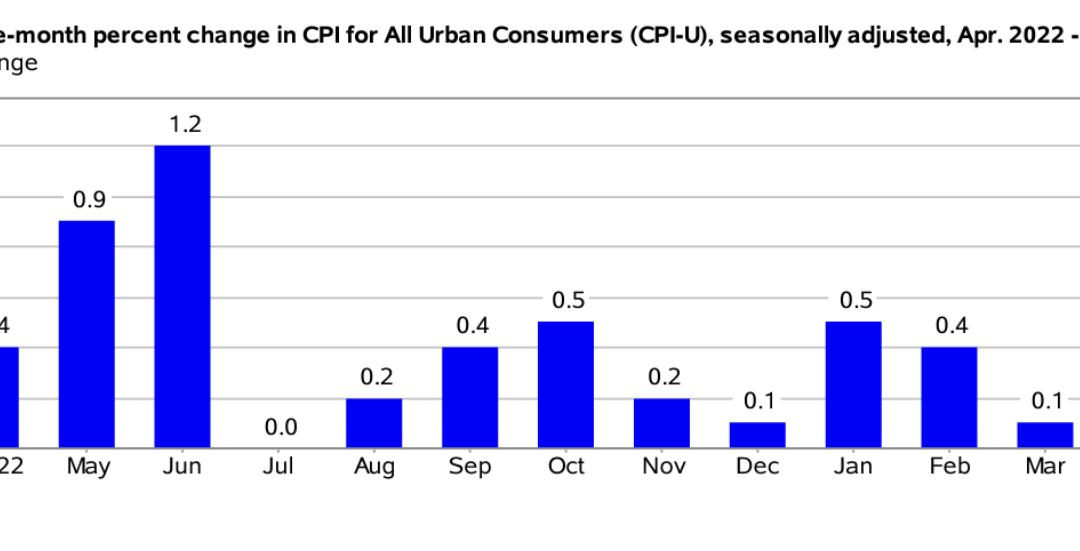
by Liam Hunt | May 10, 2023 | Monthly CPI Updates
The Consumer Price Index for All Urban Consumers (CPI-U) increased by 0.4% on a seasonally unadjusted basis in April 2023, according to the Bureau of Labor Statistics report published May 10. Year-over-year, before seasonal adjustment the all-items index grew by 4.9%, which is slightly down from 5.0% in March.
Overall, the April 2023 CPI report came in better than expected for market watchers. Independent observers generally expected a steady inflation rate of 5.0% for April, so the slightly better-than-expected results of 4.9% generated a jump of 150 points in the Dow Jones.
This month’s CPI report indicates that the Federal Reserve’s hawkish monetary policy is working as intended, as inflation has been continually trending downward for the better part of a year. However, there remains a long road ahead to get to the 2.0% target rate that the Fed has maintained as a policy aspiration.

Source: Bureau of Labor Statistics
April’s monthly CPI figure (0.4) came in significantly higher than the previous month’s (0.1). This is due to the fact that March 2022 saw significant increases in oil, gas, and natural resource prices during the early days of the Russian invasion of Ukraine, creating a skewed base-year effect.
Overall, heightened consumer costs for shelter, used cars and trucks, and gasoline were the main drivers behind April’s 2023 CPI increase.
Food Prices
The food index went unchanged in April, while the food at home index fell (-0.2%), which is a deceleration from the previous month’s drop of (-0.3%). Fortunately for American families, four out of six grocery indices fell in April, providing some relief at the supermarket checkout. Notably, fruits and vegetables fell (-0.5%), and meats, poultry, fish, and eggs fell as well (-0.3%).
By contrast, certain food items increased in price. Most notable were cereals and bakery goods, which increased (+0.2%) in April, although they rose by an even higher margin during the previous month (+0.4%).
Energy Prices
Energy costs rose in April (+0.6%) after falling (-3.5%) in March. Gasoline, in particular, rose by +3.0% whereas the natural gas index declined (-12.2%) on the year. At the same time, the fuel oil index also dropped off precipitously (-20.2%) while electricity costs rose by +8.4%. In other words, energy costs either rose or fell by varying margins depending on the segment of the market and the specific energy type.
Core April 2023 CPI
The core CPI data for April 2023, which refers to the monthly CPI figure less food and energy, rose 0.4% month-over-month in April, matching its pace in March. Below, we’ve shared a brief breakdown of the main price movements seen within April’s core CPI reading:
- Shelter index: +0.4% (+0.6% in March)
- Used cars and trucks: +4.4%
- Motor vehicle insurance: +1.4%
- Airline fares index: (-2.6%)
- New vehicles: (-0.2%)
- Medical care index: (-0.3%)
- Shelter index: +8.1% (comprising 60% of the core CPI’s total increase)
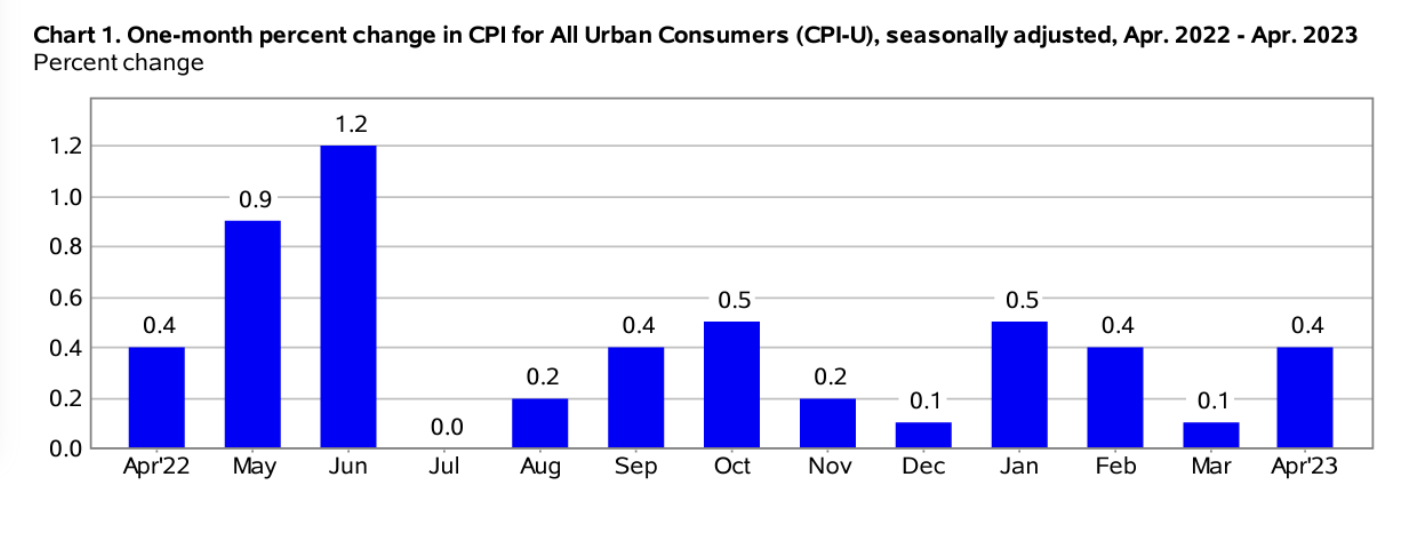
Source: Bureau of Labor Statistics
Seasonally Unadjusted CPI Data for April 2023
Prior to seasonal adjustment, the CPI-U data for the month increased (+0.5%), rising to an index level of 303.363. Due to their unadjusted nature, these data include normal price fluctuations that regularly occur at the same time and by the same margins every year.
Protect Your Portfolio from Inflation in 2023
Every month, the U.S. dollar loses value, and the relative purchasing power of the American consumer declines. To combat the negative effects of inflation, consider speaking to your financial advisor about diversifying your investment portfolio with alternative assets that may help insulate your savings from the devaluation effects of inflation.
Hard assets such as gold and silver have historically performed well during periods of economic uncertainty and high inflation. As an inflation hedge, its often sought after by investors looking to actively manage risk in their investment strategy. To get started with gold or silver investing, consider opening an account with one of America’s best gold IRA service providers. The current top-ranked provider of gold IRAs is Noble Gold—you can read an exclusive review of Noble Gold here.
To keep tabs on inflation in the months ahead, don’t forget to use our exclusive CPI inflation calculator tool to see how macroeconomic conditions are affecting your purchasing power.

by Liam Hunt | Apr 12, 2023 | Monthly CPI Updates
The Consumer Price Index for All Urban Consumers (CPI-U) increased by 0.1% on a seasonally adjusted basis, per the Bureau of Labor Statistics. Year-over-year, before seasonal adjustment the all-items index grew by 5.0%, which is down from 6.0% in February.
March’s CPI data is in step with a continuing trend of inflation deceleration that has been ongoing all year after peaking at 9.1% in June of last year. According to a Yahoo Finance report, consumer prices in March came in less than expected, which was around 5.2%.
In short, the March 2023 CPI-U data indicates a cool-off is still underway, with deceleration trending toward the Fed’s target rate of 2.0% by next year.
Shelter costs were the major driving force in March’s inflation figure. Although the energy index declined in March and the food index remained unchanged from last month, the index for all items less food and energy rose 0.4%. Overall, the March 2023 CPI increase (5.0%) constituted the smallest year-over-year (Y-o-Y) increase since May 2021.
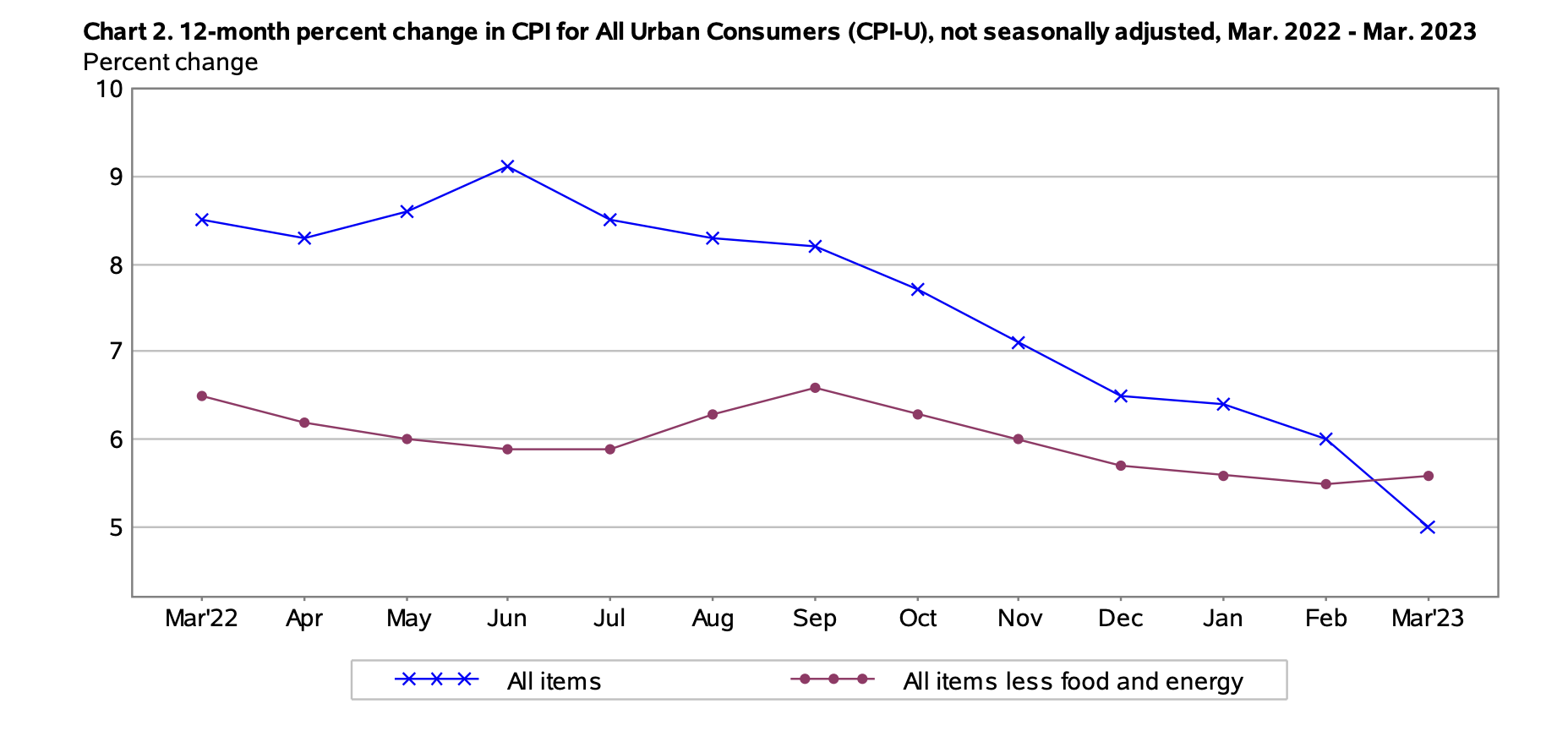
Source: Bureau of Labor Statistics
As indicated in “Table A” below, energy prices, including gasoline, as well as used cars and trucks put significant downward price pressure on the CPI in the month of March. Meanwhile, food at home (8.5%), food away from home (8.8%), and transportation services (13.9%) asserted a lot of upward pressure that more than offset the price reductions in the energy sector.
Most significant is the drop in energy prices which, compared to February 2023, saw dramatic price drops. This can largely be attributed to the major price increases in oil and gas following the Russian invasion of Ukraine in March of last year.
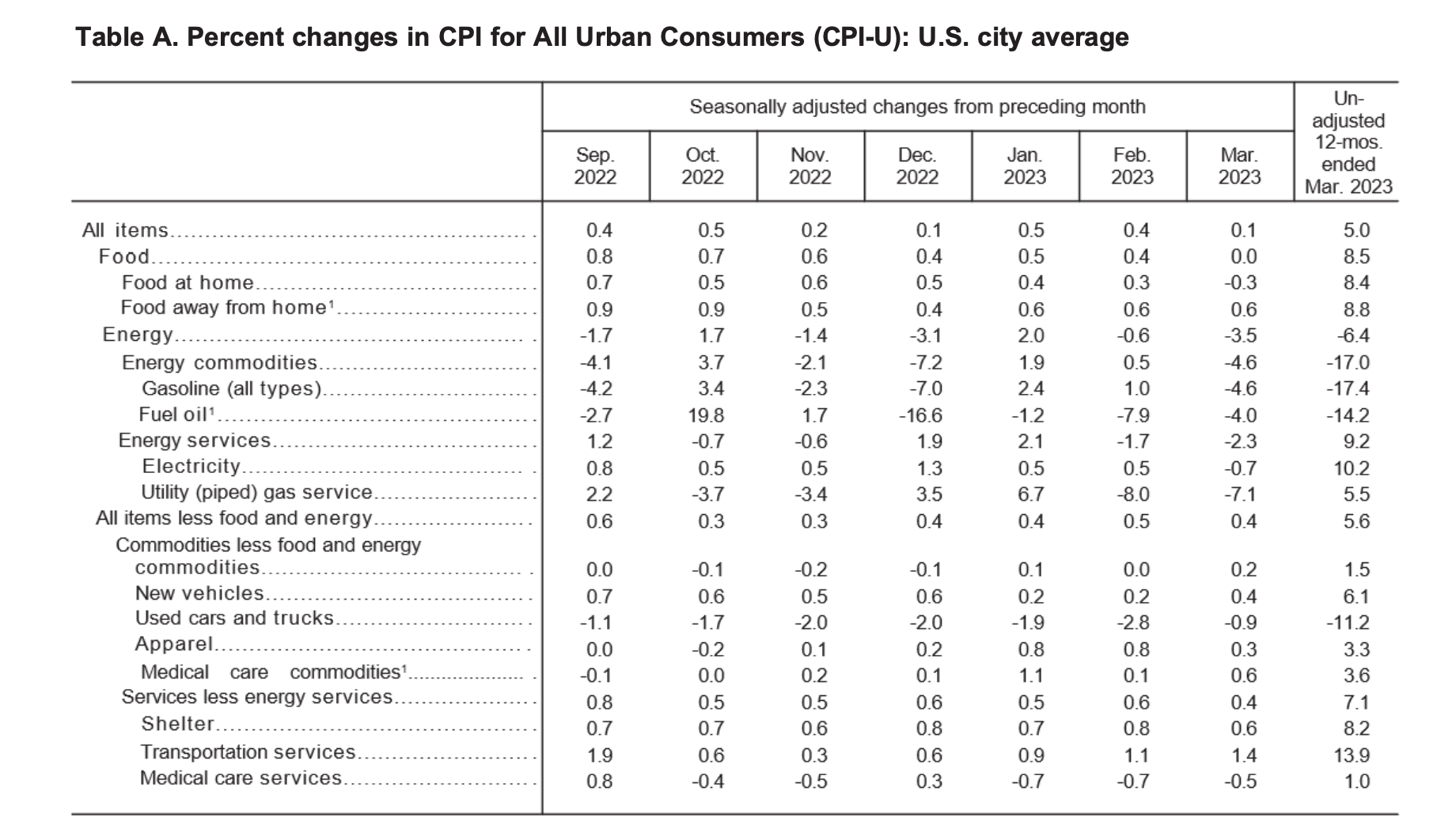
Largest Y-o-Y Drop Since May 2021
The most important story in the March 2023 CPI report is that inflation is dramatically cooling off from its mid-2022 high point. In fact, this month saw the smallest Y-o-Y increase in the CPI-U since May 2021. This appears to indicate that the Federal Reserve’s hawkish interest rate policy appears to be working as intended, and that future rate hikes are likely to continue (albeit at a slower pace) until the target 2% inflation benchmark is reached.
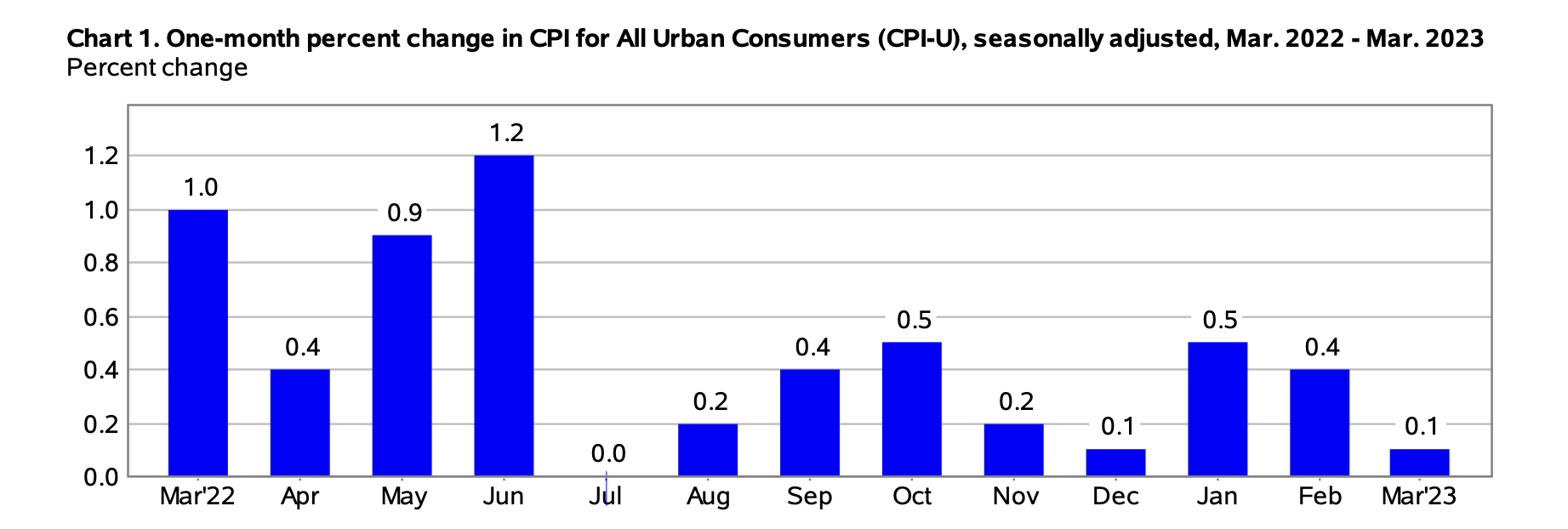
Core CPI Still Cause for Concern
Overall, the core CPI (CPI-U less food and energy) is still hot, coming in at 0.4% after a 0.5% increase in February. This is due primarily to rent increases and increases in the homeowners’ equivalent rent indices increasing by 0.5% in March. Therefore, policymakers are likely to target rent and housing affordability concerns through legislative efforts in order to mitigate the negative effects of housing costs on the CPI.
Ready to Protect Your Retirement Savings?
While inflation appears to be cooling, high interest rates and cost-of-living increases are taking a toll on the average American family. With inflation still far above the Fed’s target benchmark, investors are losing more and more of their savings every year due to the depreciation of the U.S. dollar.
Want to learn more about how inflation is impacting American households? Check out our exclusive calculator widget, and don’t forget to subscribe to our monthly newsletter if you haven’t already—this way, you can stay informed of the latest CPI developments immediately after they’re released.
Source Cited: https://www.bls.gov/news.release/pdf/cpi.pdf
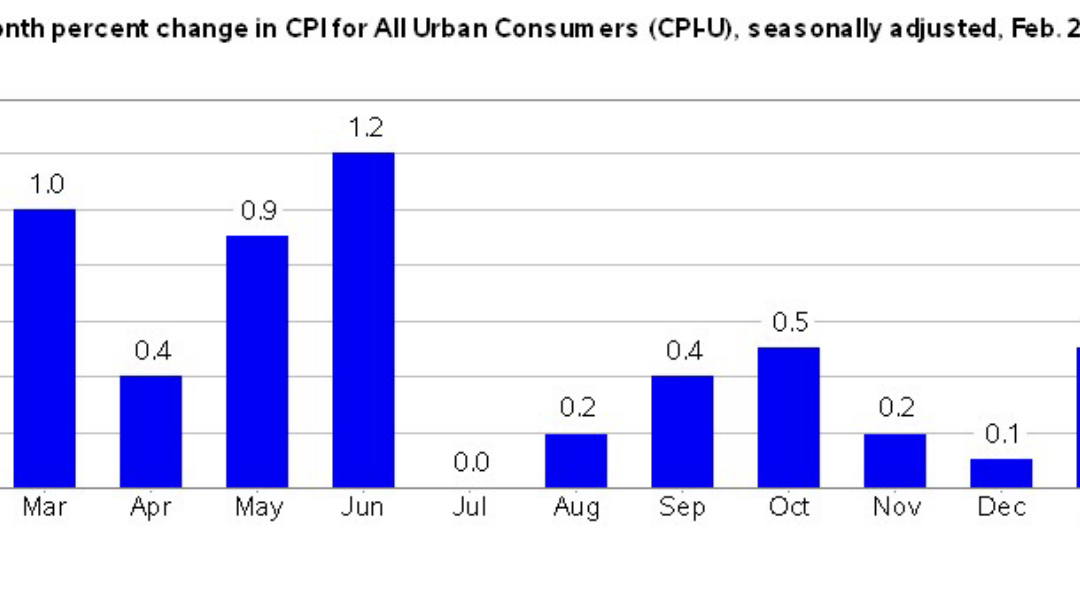
by Liam Hunt | Mar 14, 2023 | Monthly CPI Updates
The Consumer Price Index for All Urban Consumers (CPI-U) increased by 0.4% on a seasonally adjusted basis, per the Bureau of Labor Statistics. Year-over-year, before seasonal adjustment the all items index grew by 6.0%, which is down from 6.4% in January.
According to CNBC, the biggest culprits driving inflation this month were eggs (+55.4%), butter and margarine (26.9%), and airfare (26.5%). The greatest counterweights were televisions (-14.8%) and used cars and trucks (-13.6%), which both cooled down considerably.
February’s CPI data continues a general deceleration of inflation that has been ongoing for several months, and which represents a considerable cooling off from the pandemic-era peak of 9.1% in June 2022. Prior forecasts pegged February’s seasonally adjusted CPI to come in at 6.0%, which turned out to be exactly on the money. However, core CPI came in a little hotter than expected, by precisely one-tenth of one percent at 0.4% (5.5% year-on-year).
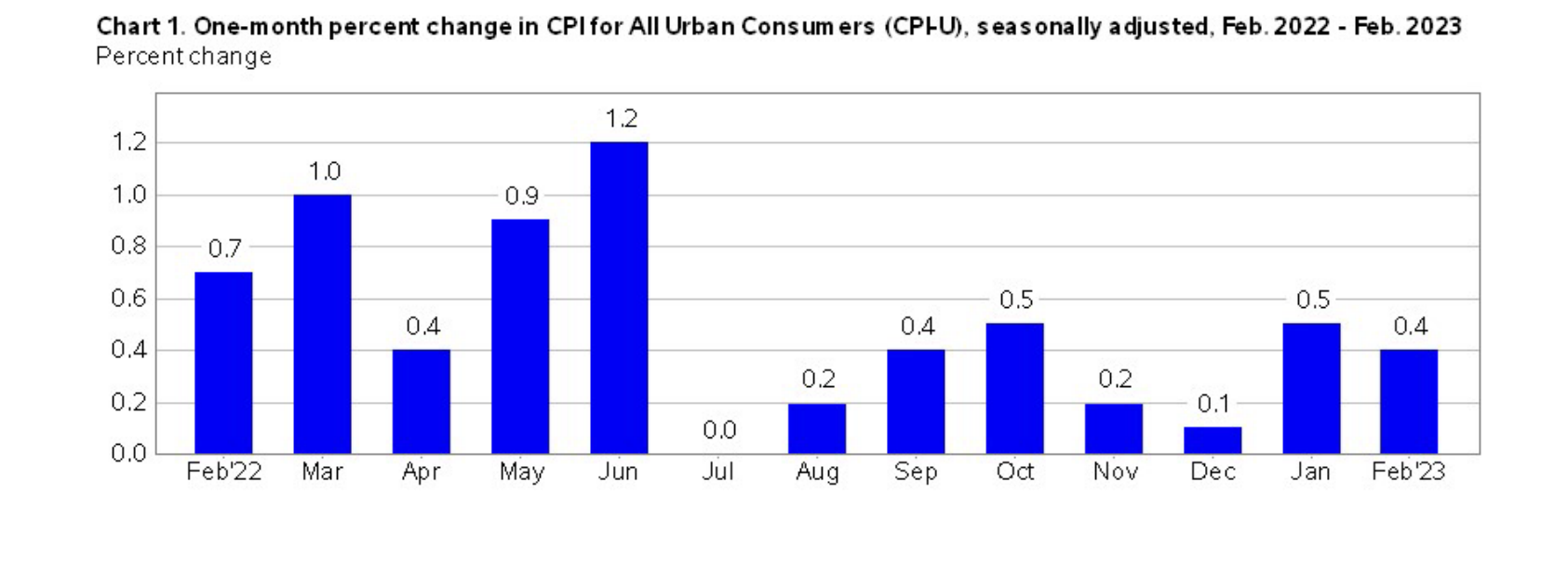
Source: U.S. Bureau of Labor Statistics
Food
In February, the food index rose by +0.4% while the food at home index rose at a slightly lesser pace of +0.3%. Compared to January, five out of six food categories increased, including nonalcoholic beverages and dairy and related products.
On the other hand, certain food categories fell, including poultry, fish, and eggs, which decreased (-0.1%) in February, which constitutes the first decrease in this food category in 14 months (December 2021).
Energy
When it comes to energy prices, the energy index fell (-0.6%) in February, following a fairly large 2.0 percent increase in January. Bringing the CPI-U down was the natural gas index, which dropped by the largest margin since 2006 (-8.0%).
Over the past 12-month period, the energy index hiked +5.2%, whereas the fuel oil index rose +9.2% in the same period alongside electricity at +12.9% and natural gas at +14.3%.
Gasoline costs fell (-2.0%) in February, providing much-needed price relief at the pump for American consumers.
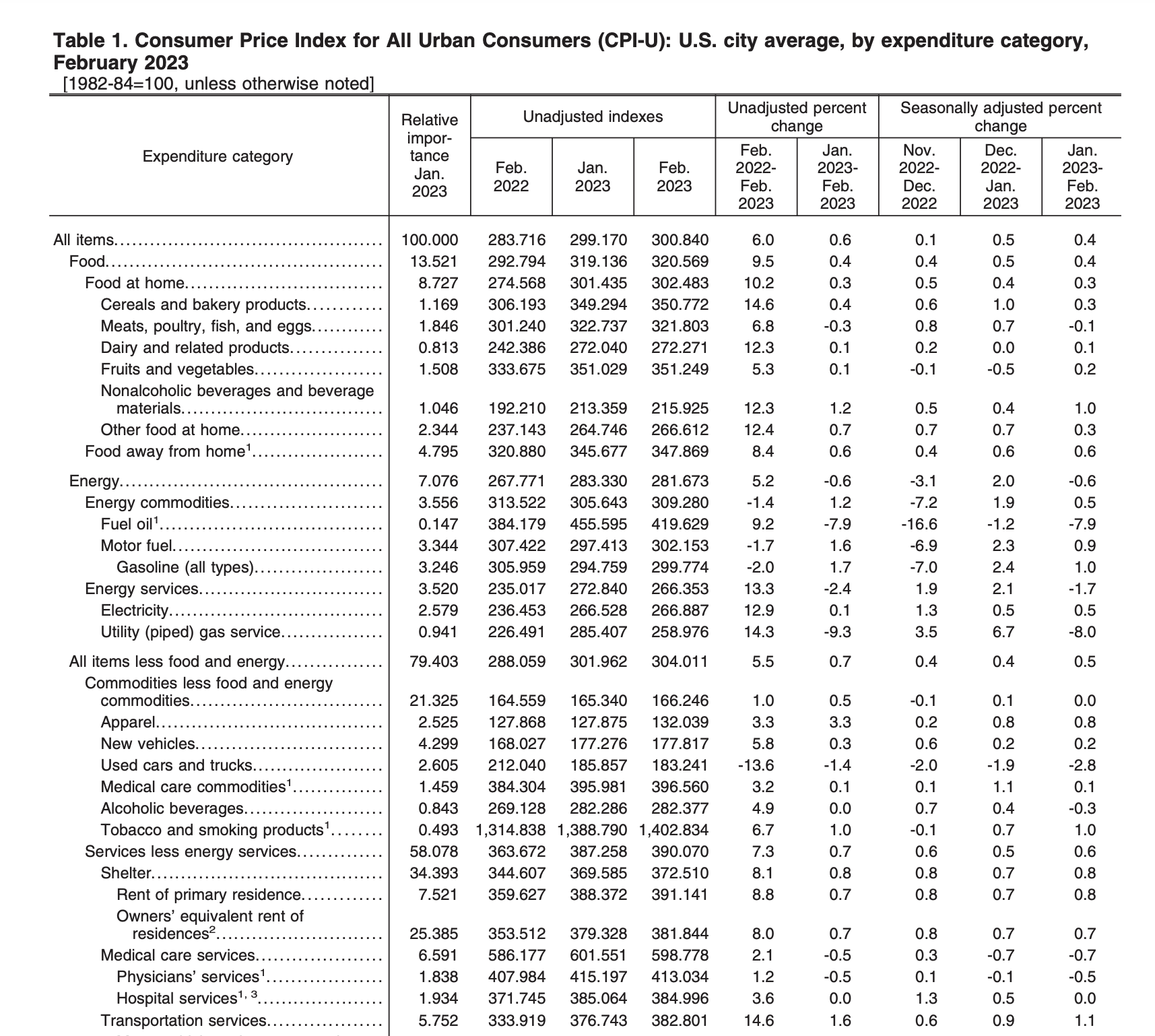
Source: U.S. Bureau of Labor Statistics
All Items Less Food and Energy (February 2023 Core CPI)
February 2023’s core CPI came in at 0.5%, which represents a slight increase over many market watchers’ expectations of 0.4% and constituting a rise from 0.4% in January. Driving up the core CPI was the shelter index, which rose 0.8% and the index for rent which went up 0.8% as well. Lodging away from home rose by 2.3% in February.
Within the core CPI, the shelter index was the greatest driver of the index’ larger-than-anticipated outcome in February. Additional upward pressures were asserted by prices for motor vehicle insurance by +14.5% and household furnishings at +6.1%. However, numerous areas within the core index fell, including the medical care index (-0.5%) and the index for physicians’ services (-0.5%).
Inflation Matches Expectations in February: Interest Rate Relief to Come?
Given that February’s CPI report matched analysts’ expectations, we may see Federal Reserve Chairman Jerome Powell announce a temporary off-ramp of the central bank’s quantitative tightening policy. As speculated on CNBC Television on Tuesday, the current crisis at Silicon Valley Bank, with the threat of a contagion spilling over into over sectors of the U.S. and global economy, it may be in the Fed’s best interest to pause rate hikes following the next Federal Open Market Committee meeting on March 21 and 22.
In short, February’s report indicates that the Fed’s hawkish interest rate policy, which has seen multiple .25 and .50 basis point hikes as of late, has been largely successful in restraining inflation. This month’s CPI came in exactly where experts predicted they would, with the slight exception of the core CPI which was only a bit hotter than anticipated. Given the ongoing systemic problems in the lending market, we may, however, see the Fed’s interest rate policy relaxed through the spring, which may temporarily give rise to a new rebound period in the inflation rate.
Curious about how inflation is impacting your retirement and the economy at large? Check out our calculator widget to see how the CPI is affecting your financial freedom, and don’t forget to subscribe to our monthly newsletter if you haven’t already—this way, you can stay abreast of the latest CPI developments as soon as they’re released.
Source Cited: https://www.bls.gov/news.release/cpi.nr0.htm
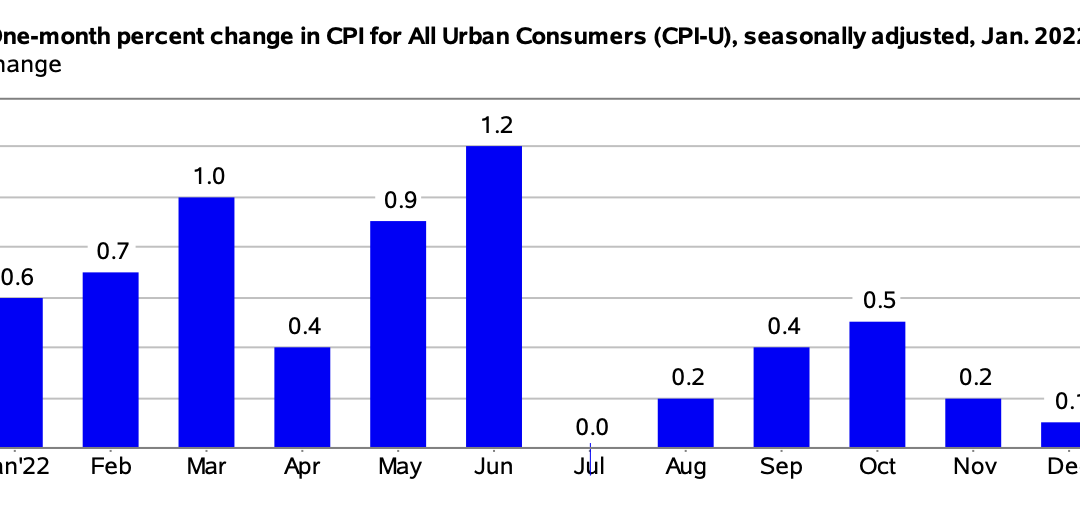
by Liam Hunt | Feb 14, 2023 | Monthly CPI Updates
The Consumer Price Index for All Urban Consumers (CPI-U) increased by 0.5% on a seasonally adjusted basis, reported the Bureau of Labor Statistics. Year-over-year, before seasonal adjustment the all items index grew by 6.4%.
The primary contributing variable to the acceleration in the CPI-U was shelter, but other items such as food, gasoline, and home heating costs also applied upward pressure on the CPI-U.
Even though they represented a modest easing in inflation, January’s CPI figures, on the whole, came in slightly worse than analysts expected. For example, Bloomberg forecasted a deceleration to 6.2%—a whole 0.2 points below the actual figure.

Source: U.S. Bureau of Labor Statistics
Food
In January, the index for food rose by 0.5%, following a 0.4% rise in December 2022. Of the six major grocery store indices utilized by the BLS, four of them increased month-over-month. Meats, poultry, fish, and eggs increased by 0.7% in January while the egg cost index increased 8.5%.
By contrast, fresh fruits and vegetables lowered in price in January, falling 0.5%, while dairy prices remained the same as in December 2022.
Gasoline Prices
January’s gasoline prices increased 2.4% month-over-month. Before seasonally adjusting, the price at the pump rose by 3.2%. Therefore, consumers paid considerably more to fill their car’s gas tank in January compared to the month prior.
Energy
The energy index rose 2.0% in January and 8.7% year-over-year, representing a stark increase due in large part to the ongoing Russian invasion of Ukraine. Over the past 12-month period, the fuel oil index rose 27.7% while electricity costs rose 11.9% and natural gas rose 26.7%.

Source: U.S. Bureau of Labor Statistics
All Items Less Food and Energy
January 2023’s CPI report indicated that the core index (i.e., less food and energy) rose 0.4%. Main contributors to the rise in the core index were shelter costs, motor vehicle insurance, recreational costs, clothing and apparel, and household furniture and goods. Those that decreased, by contrasted, were used cars and trucks, healthcare costs, and airfare.
The shelter index was the single strongest factor in January’s rise in the core CPI. The shelter index alone rose 7.9% compared to last year, which was responsible for roughly 60% of the total upward pressure on January 2023’s CPI less food and energy.
In sum, while continuing a multi-month downtrend in overall inflation, January 2023’s CPI report was higher than many market watchers expected.
Want to learn more about how inflation is impacting the economy? Take a look at our calculator widget to keep tabs on how the CPI is impacting your financial life, and don’t forget to subscribe to our monthly newsletter if you haven’t already.
Source Cited: https://www.bls.gov/news.release/cpi.nr0.htm
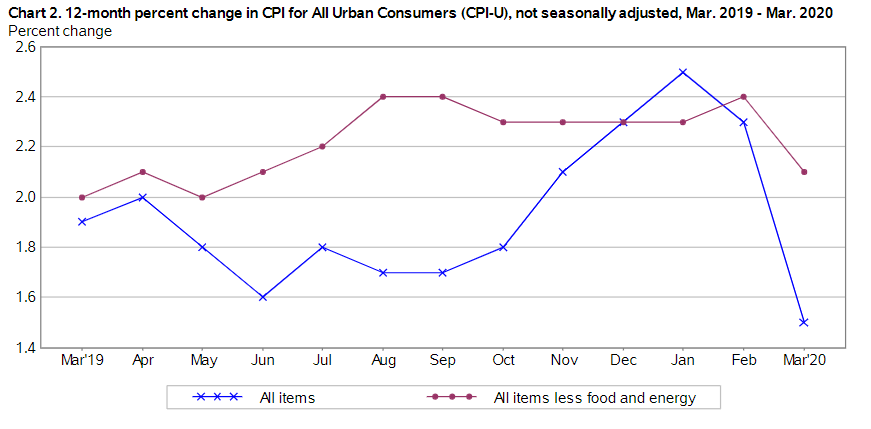
by Liam Hunt | Apr 10, 2020 | Definitions
The Consumer Price Index for All Urban Consumers (CPI-U) dropped 0.4% in March according to a new summary report by the U.S. Bureau of Labor Statistics. The 0.4% drop in consumer prices is reported on a seasonally-adjusted basis, and represents the largest single-month decline since January 2015. From March 2019 to March 2020, the CPI-U increased 1.5% before adjustment and consumer prices rose 0.1% in both February and January.
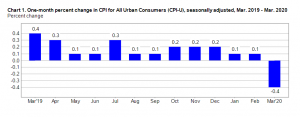
(Source: U.S. Bureau of Labor Statistics)
The drop in U.S. consumer prices in March is led by two principal factors. First, the price of oil reaching 18-year lows due to reduced industrial and consumer demand in tandem with the ongoing Saudi-Russian oil price war. Second, a generally strained U.S. economy due to the Covid-19 pandemic.
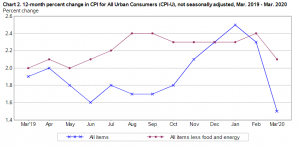
(Source: U.S. Bureau of Labor Statistics)
Food Index
Despite a large overall drop in the CPI-U, the food index rose by 0.3% in March. This price movement represents a minor cool-down from February’s 0.4% increase in the food index. The Food at home index shot up 0.5%, which matches its growth in February.
In March, all six grocery store food group indexes increased during the month of March. Consumer prices for non-alcoholic beverages increased by 0.9% and the fruits and vegetables index rose 0.8% following a stagnant month in February.
The food away from home index rose a more modest 0.2% in March, which matches its February increase. The Labor Department reported that the index for food away from home rose 3.0% over the past year, and the food at home index rose by 1.1%.
All Items Less Food and Energy Index
In March, the index for all items less food and energy fell by 0.1%. The indexes for rent and owners’ equivalent rent edged up by a modest 0.3%, although these increases were offset by a 6.8% fall in the index for lodging away from home.
Although the airline fares index fell by only 0.3% in February, March saw a much more pronounced decline of 12.6%. After four consequent months of increases, the apparel index fell by 2.0% in March and the index for new consumer vehicles fell by 0.4% in March despite increasing through February.
The medical care index rose 0.4% in March amid the developing novel coronavirus pandemic. The physicians’ services index rose 0.3% while the hospital services index rose by 0.4% in March. The prescription drug index fell by 0.2%. In the past 12-month period, the index for all items less food and energy rose by 2.1%.
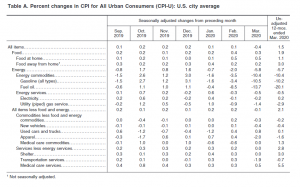
(Source: U.S. Bureau of Labor Statistics)
Energy Index
Notably, the U.S. energy index fell by 5.8% in March, marking its largest drop in over five years. The monthly decrease was led by a sharp drop in gasoline prices, as the gasoline index declined by 10.5% after seasonal adjustment.
Other energy index items also fell in March, including the fuel oil index (-13.7%), the natural gas index (-1.4%), and the electricity index (-0.2%). In the past year, the U.S. energy index dropped by 5.7%, which the Labor Department reports to be the largest 12-month decline since the year ending August 2016.
Source cited: https://www.bls.gov/news.release/archives/cpi_04102020.htm



















